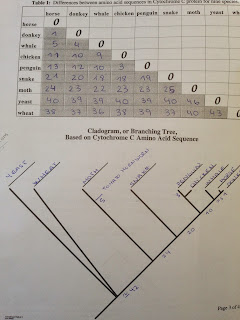Cytochome-C Comparison Lab
PURPOSE: To compare the relatedness between organisms by examining the amino acid sequence in the protein, Cytochrome C.
Cytochome-C
Small protein from eucariotic cell,
Associated will in member of the mitocondray,
Is molecules oxidizable ,
Hemoproteinthe
Funcion part of electon transporchain produce energi (ATP)
This test will see the difference in cytochrome-C have the following animals
Horse -Donki- - MAMMALS
Chiken-Penguin- BIRDS
Snake-REPTILE
Silkworm moth-INSECT
Yeast-FUNGI
Wheat-PLANTS
METHOD
Compare the amino acid sequence of Cytochrome-C in various organisms.
. Count and record the total number of differences.
Share your data with the rest of the class and complete
Make a branching tree, or cladogram with results
TABLE
Differences between amino acid sequences in Cytochrome C protein for nine species.
Horse
|
Donkey
|
Whale
|
Chiken
|
Penguin
|
Snake
|
Moth
|
Yeast
|
Wheat
|
|
Horse
|
0
|
||||||||
Donkey
|
0
|
0
|
|||||||
Whale
|
5
|
4
|
0
|
||||||
Chiken
|
11
|
10
|
9
|
0
|
|||||
Penguin
|
13
|
12
|
10
|
3
|
0
|
||||
Snake
|
21
|
29
|
18
|
18
|
19
|
0
|
|||
Moth
|
24
|
23
|
22
|
23
|
23
|
26
|
0
|
||
Yeast
|
40
|
39
|
39
|
40
|
39
|
40
|
46
|
0
|
|
Wheat
|
38
|
37
|
36
|
39
|
39
|
37
|
40
|
43
|
0
|
Cladogram
QUESTIONS
1-) How many Cytochrome C amino acid sequence differences are there between chickens and turkeys? 0
2-)Make a branching tree, or cladogram for chickens, penguins, and turkeys.
3-) Predict the number of Cytochrome C amino acid sequence differences you would expect to see between
a). horse and zebra? 1-2 aprox
b). donkey and zebra?1-2 aprox
4-) What other information did you use to make this prediction?
Horse
|
Penguin
|
Snake
|
Tuna
|
Moth
|
Yeast
|
Wheat
|
|
Tomato
hornworm moth
|
26
|
18
|
24
|
28
|
5
|
42
|
38
|
5-) List three other things used to determine how organisms are related to each other? If they can reproduce and the offspring is fertile compering organs proce anatomic
6-) Explain why more closely related organisms have more similar Cytochrome C ? Are evolutionarily and not as separate DNA canviado not therefore less time with less canvios occur in the evolution of the species
7-) Other data, including other genes, suggests that fungi are more closely related to animals than plants.What are some reasons that the Cytochrome C data suggests that fungi, plants, and animals are equally distantly related? Based on a number of mutations as over forty are no longer compatiobles among them, have undergone many mutations

.JPG)